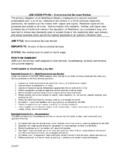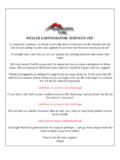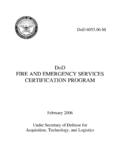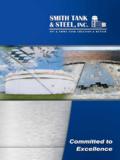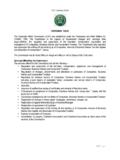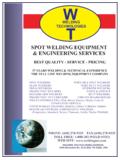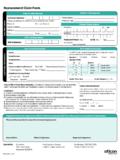Transcription of ANSI/ISA-S5.4-1991
1 American National September 9, 1991 Instrument Loop DiagramsCopyright 1986 by the Instrument Society of America. All rights reserved. Printed in the UnitedStates of America. No part of this publication may be reproduced, stored in a retrieval system, ortransmitted in any form or by any means (electronic, mechanical, photocopying, recording, orotherwise), without the prior written permission of the Alexander Box 12277 Research Triangle Park, North Carolina Instrument Loop DiagramsISBN 1-55617-227-3 PrefaceThe information contained in the Preface and Forward is for information only and is not a part of the standard is prepared as part of the service of ISA toward a goal of uniformity in the field of instrumentation. To be of real value, this document should not be static, but must be subject to periodic review. Toward this end, the Society welcomes all comments and criticisms, and request that they be addressed to the Secretary, Standards and Practices Board, ISA, 67 Alexander Drive, P.
2 O. Box 12277, Research Triangle Park, NC 27709. Telephone (919) 549-8411, e-mail: ISA Standards and Practices Department is aware of the growing need for attention to the metric system of units in general and the International System of Units (SI) in particular, in the preparation of instrumentation standards. The Department is further aware of the benefits to users of ISA standards of incorporating suitable references to the SI (and the metric system) in their business and professional dealings with other countries. Toward this end, this Department will try to introduce SI-acceptable metric units in all new and revised standards to the greatest extent possible. The Metric Practice Guide, published by the Institute of Electrical and Electronics Engineers as ANSI/IEEE Std. 268-1982, and future revisions will be the reference guide for definitions, symbols, abbreviations, and conversion is the policy of ISA to encourage and welcome the participation of all concerned individuals and interests in the development of ISA standards.
3 Participation in the ISA standards-making process by an individual in no way constitutes endorsement by the employers of the individual, of the ISA, or of any of the standards that ISA the time it approved this standard revision, the Committee had the following members:NAMECOMPANYW. Richard ShawStearns Roger*Gerald V. BartaDow Corning CorporationWilliam H. ClearyStone & WebsterRichard L. EmersonBechtel Power CorporationEdward E. OlinekStearns Roger*Raymond RobertsonPPGR obert P. LarkinFord, Bacon & DavisJ. SlavinDelmar ControlsJohn LorenzLeeds & NorthrupRichard E. TerhuneConsultantMike WileyLummus CrestThomas C. McAvinewMetropolitan Denver Sewage Disposal District*One vote4 recommended practice was approved for publication by the ISA Standards and Practices Board in Bishop, Vice-PresidentChevron CongerFisher Controls Int'l. GrossEagle TechnologyH. HopkinsUtility Products of ArizonaR. JonesDow Chemical CompanyA.
4 McCauleyChagrin Valley Controls, NesvigERDCO Engineering PrescottMoore Products CompanyD. RapleyRapley Engineering ServiceR. ReimerAllen-Bradley CompanyJ. RennieFactory Mutual Research CorporationW. WeidmanGilbert/Commonwealth, WhetstoneNational Inst. of Standards & TechnologyM. WidmeyerThe Power Supply SystemP. Bliss*ConsultantW. Calder III*The Foxboro CompanyB. Christensen*ConsultantL. Combs*ConsultantR. Galley*ConsultantT. Harrison*Florida State UniversityR. Jones*Philadelphia Electric CompanyR. Keller*ConsultantO. Lovett*ConsultantE. Magison*Honeywell, Marvin*ConsultantW. Miller*Moore Products CompanyJ. Mock*Bechtel Western Power CorporationG. Platt*ConsultantJ. Williams*Stearns Catalytic Corporation*Director ForewordInstrument loop diagrams are suitable for general use throughout industry. It is important to consider their value for design, construction, checkout, start-up, operation, maintenance, rearrangement, and reconstruction.
5 Benefits can include reduction in engineering costs, improved loop integrity and purchasing accuracy, and easier maintenance instrument loop diagram can be effective on any size project from one or two loops up to large and complex installations. It can present on one sheet all the information or references to the information needed for installation, checkout, start-up and maintenance. Without the use of an instrument loop diagram, that information is spread among many other documents and is not readily available. Updating this single diagram to "as built" status is more easily achieved than updating the variety of other standard does not mandate the style and content of instrument loop diagrams, but rather it is a consensus concerning their generation. As such, it has the same strengths and weaknesses as other consensus standards. Its primary strength is that the format and content guidelines apply to the majority of instrumentation applications.
6 Its weakness is that it is not specific enough to satisfy the special requirements of particular interest ISA Standards Committee on Instrument Loop Diagrams operates within the ISA Standards and Practices Department. This committee is appreciative of the work of previous committees and has tried to treat their work with respect. This committee would like to acknowledge the work of the committee in developing , Instrumentation Symbols and Identification. One of our major goals has been to have the standard conform to the revised Contents1 Purpose ..92 Scope .. 93 Applications .. Serve many Design .. Construction .. Start-up .. Operation .. Maintenance .. Modification .. 104 Definitions .. 105 Content .. 106 Format ..127 Symbols .. Instrument connection and action information .. General terminal or bulkhead symbol .. Instrument terminals or ports .. Instrument system energy supply.
7 Identification of instrument action .. 148 Examples .. 14 Provide guidelines. This standard will provide guidelines for the preparation and use of instrument loop diagrams in the design, construction, start-up, operation, maintenance, and mod-ification of instrumentation Assist understanding. This standard will assist the understanding of instrument loop dia-grams and improve communications among technical, non-technical, management, design, con-struction, operating, and maintenance Additional information for individual loop. This standard establishes minimum required information and identifies additional optional information for a loop diagram for an individual instru-mentation loop. This loop is typically part of a process depicted on the class of engineering drawings referred to as Piping and Instrument Drawings (P&IDs). Suitability. This standard is suitable for use in the chemical, petroleum, power generation, air conditioning, metal refining, and many other Specialty fields.
8 Certain fields, such as astronomy, navigation, and medicine, use very specialized instruments that are different from the conventional industrial process instruments. No specific effort to have this standard meet the requirements of those fields has been made. However, this standard is flexible enough to meet many of the needs of specialty Serve many purposes. Loop diagrams serve many purposes. Several of these stated below are in the chronology of project Design1)Illustrate control philosophy and confirm the completeness of submitted data2)An extension of P&IDS, which show the components and accessories of the instrument loop, connections between devices, and identification of component action3)The specification of instrument hardware items and a means of communicating requirements to Construction1)Panel instrumentation interconnections and checkout diagram10 )Instrumentation installation references and special requirements3)Instrumentation interconnections4)Instrumentation loop checkout5)Inspection and Start-up1)Pre-start-up commissioning and calibration2)Training tool and Operation1)Communication medium between operations, maintenance, and engineering personnel2)Training device for Maintenance1)Troubleshooting2)Routine calibration3)Preventative and corrective maintenance Modification1)
9 Rearrangement2)Reconstruction3)Enhanceme nt4 DefinitionsThis standard is an extension of the communications defined by , Instrumentation Symbols and Identification , and the definitions of that standard therefore apply. The guidelines of this standard cover the content of a loop diagram drawing, and it does not produce any new definitions for that presentation General. The instrument loop diagram is a composite representation of instrument loop information. It contains all associated electrical and piping connections and should contain all of the information needed to accommodate the intended uses. Classified below are minimum require-ments and some established options that can be used to match the desired Minimum content requirements. As a minimum, an instrument loop diagram shall contain the information covered )Identification of the loop and loop components shown on the P&IDS. Other principal components of the loop to be shown and identified under , Instrumentation Symbols and Identification.
10 2)Word description of loop functions within the title. If not adequate, use a supplemental note. Identify any special features or functions of shutdown and safety )Indication of the interrelation to other instrumentation loops, including overrides, interlocks, cascaded set points, shutdowns and safety )All point-to-point interconnections with identifying numbers or colors of electrical cables, conductors, pneumatic multitubes, and individual pneumatic and hydraulic tubing. This identification of interconnections includes junction boxes, terminals, bulkheads, ports, and grounding )General location of devices such as field, panel, auxiliary equipment, rack, termination cabinet, cable spreading room, I/0 cabinet, )Energy sources of devices, such as electrical power, air supply, and hydraulic fluid supply. Identify voltage, pressure, and other applicable requirements. For electrical sources, identify circuit or disconnect )Process lines and equipment sufficient to describe the process side of the loop and provide clarity of control action.



